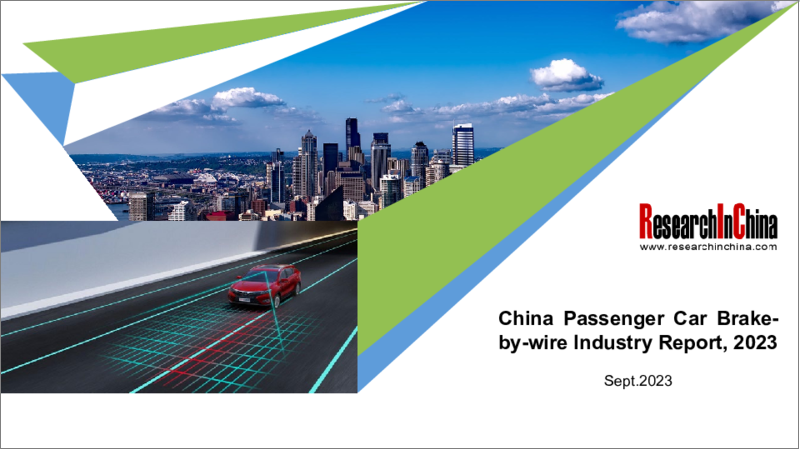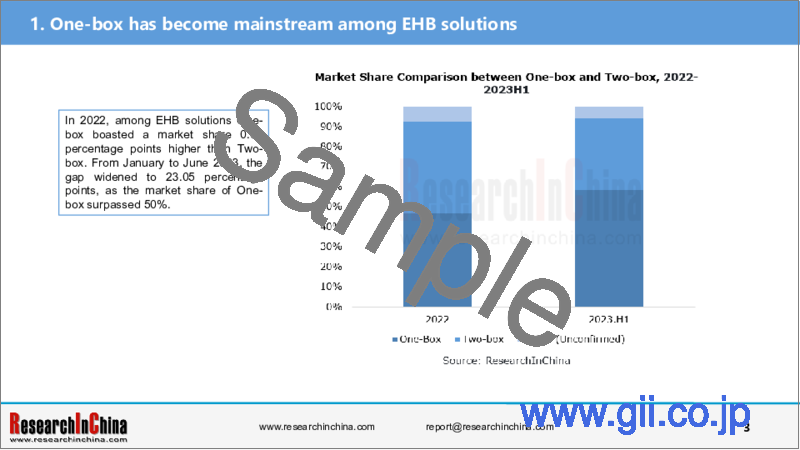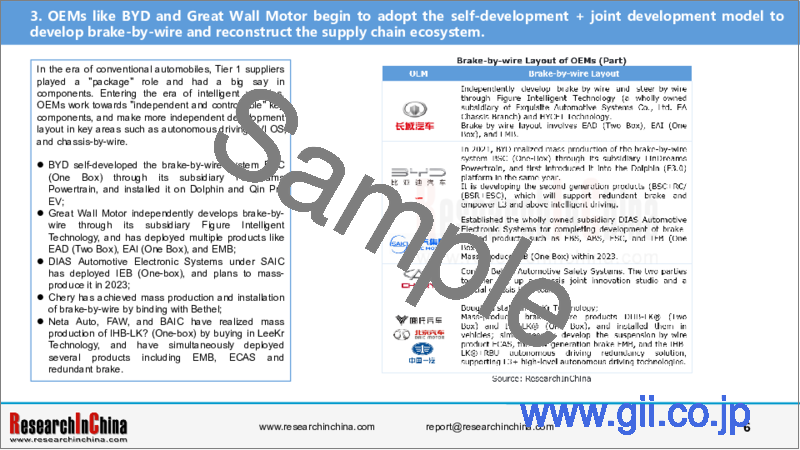|
|
市場調査レポート
商品コード
1348747
中国の乗用車用ブレーキバイワイヤ産業(2023年)China Passenger Car Brake-by-wire Industry Report, 2023 |
||||||
|
|||||||
| 中国の乗用車用ブレーキバイワイヤ産業(2023年) |
|
出版日: 2023年08月14日
発行: ResearchInChina
ページ情報: 英文 240 Pages
納期: 即日から翌営業日
|
- 全表示
- 概要
- 目次
現在、NIO、Li Auto、Xpengなどの新興自動車ブランドは、ブレーキバイワイヤを標準構成として提供しています(2023年1月~6月、新エネルギー車へのブレーキバイワイヤの搭載率は60%を超えました)。燃料車へのブレーキバイワイヤの搭載も増加しており、TANK 300/500、Tiggo 7/8、Tiggo 7 Plus/8 Plus、Cadillac XT4/5/6、Cadillac CT4/5/6などが搭載されています。2025年、中国のブレーキバイワイヤの市場規模は160億人民元を超えると予測されます。
2023年1月~6月のデータでは、電動油圧ブレーキ(EHB)の搭載数は200万台に達し、前年同期比で59%の増加、搭載率は21%を超え、2022年の通年と比べて4.92ポイントの増加となっています。
当レポートでは、中国の乗用車用ブレーキバイワイヤ産業について調査し、市場規模、OEMの搭載、サプライヤーの製品レイアウトをまとめています。
目次
第1章 ブレーキバイワイヤ産業の概要
- ブレーキの分類
- ブレーキバイワイヤの開発史
- ブレーキバイワイヤーに関する政策
- ブレーキバイワイヤの開発経路
- ブレーキバイワイヤの分類
- 電気油圧ブレーキ(EHB)
- 電気機械ブレーキ(EMB)
- EHBとEMBの比較
- ブレーキバイワイヤアクセサリ
- サプライヤーのブレーキ製品レイアウト
- サプライヤーのブレーキバイワイヤ製品の概要
- EHBの搭載の全体
- EHBの搭載数と搭載率:エネルギータイプ別
- EHBの搭載数と搭載率:価格別
- EHBの搭載数:技術ルート別
- EHBサプライヤーの市場シェア
- EHBの市場規模(2023年~2027年)
- ブレーキバイワイヤの産業チェーン
- 特許:ブレーキバイワイヤの技術テーマ
- 特許:出願者ランキング
- 特許:特許マップ
第2章 乗用車用ブレーキバイワイヤシステムのサプライヤー
- Bosch
- Continental
- LeeKr Technology
- ZF
- Hitachi
- Brembo
- Mando
- Bethel
- NASN Automotive Electronics
- TriNova
- Tongyu Automotive
- Global Technology
- Tuopu Group
- JWD Automotive Technology
- FinDreams Powertrain
第3章 中国の乗用車OEMのブレーキバイワイヤシステムのレイアウト
- Great Wall Motor
- BYD
- SAIC
- Changan Automobile
- Geely
- Chery
- Chery
- FAW Hongqi
- BAIC
第4章 ブレーキバイワイヤ産業の課題と開発動向
Passenger car brake-by-wire research: One-box solution takes an over 50% share.
“China Passenger Car Brake-by-wire Industry Report, 2023” released by ResearchInChina combs through and summarizes passenger car brake-by-wire market size, installation of OEMs, and product layout of suppliers.
Brake-by-wire can't develop without vehicle electrification and intelligence. From the perspective of electrification, brake-by-wire uses electronic boosters to solve the problem of lacking vacuum power sources in new energy vehicles, and enables wheel braking energy recovery through motors to improve vehicle cruising range; in terms of intelligence, as the core module for actuation in the "perception, decision, and actuation" link, brake-by-wire system is the basis for realizing advanced intelligent driving.
At present, emerging car brands like NIO, Li Auto and Xpeng have provided brake-by-wire as a standard configuration (from January to June 2023, the installation rate of brake-by-wire in new energy vehicles was higher than 60%). The installations of brake-by-wire in fuel-powered vehicles increase as well, and TANK 300/500, Tiggo 7/8, Tiggo 7 Plus/8 Plus, Cadillac XT4/5/6, and Cadillac CT4/5/6 among others are all equipped. We predict that in 2025, China's brake-by-wire market will be valued at more than RMB16 billion.
In data's term, from January to June 2023, the installations of electro-hydraulic brake (EHB) approached 2 million units, a like-on-like jump of 59%; the installation rate exceeded 21%, up 4.92 percentage points compared to the whole year of 2022.
1. One-box has become mainstream among EHB solutions.
In 2022, among EHB solutions One-box boasted a market share 0.66 percentage points higher than Two-box. From January to June 2023, the gap widened to 23.05 percentage points, as the market share of One-box surpassed 50%.
2. In 2023, the products of Chinese and foreign suppliers have been iterated to One-Box solutions.
Compared with Two-box, One-Box integrates ESC, features high integration, light weight and low cost, and supports expansion of multifunctional parking and autonomous driving, meeting the redundancy requirements of autonomous driving.
Bosch's mass-produced integrated power brake (IPB) was installed in Cadillac XT4 for the first time in 2019, and was mounted on BYD Han in the following year. Since then, the mass adoption of the brake-by-wire solution One-Box in vehicles has started. During the same period, the foreign mass-produced One-Box products also included Continental MK Cx series and ZF IBC.
Chinese suppliers like Bethel Automotive Safety Systems mass-produced One-Box products in 2021, during which other suppliers in China were deploying Two-Box solutions. Entering 2023, all suppliers' products have been updated and iterated to One-Box solutions.
In China, suppliers that already mass-produce One-Box products include Bethel, FinDreams Powertrain, and LeeKr Technology. Among them, Bethel is backed by Chery; FinDreams Powertrain is backed by BYD; LeeKr Technology is a technology start-up with shares held by FAW, BAIC, and Neta Auto. At present, the IHB-LK® products of LeeKr Technology have supported OEMs such as Chery, Neta Auto, JAC, and Haima.
LeeKr Technology, established in 2021, mass-produced the decoupled hydraulic brake-by-wire system DHB-LK® (Two-box) and the integrated intelligent brake system IHB-LK® (One-Box) in late 2022, making itself the first technology start-up producing One-box in quantities. IHB-LK® has three versions for OEMs: standard, flagship and lightweight. As concerns redundancy solutions, LeeKr has an IHB-LK®+RBU brake-by-wire redundancy solution, meeting the requirements of L3 and above high-level autonomous driving. In 2022, the annual production capacity of IHB-LK® reached 300,000 sets, and it is projected to be expanded to 1.5 million sets during 2023-2024.
3. OEMs like BYD and Great Wall Motor begin to adopt the self-development + joint development model to develop brake-by-wire and reconstruct the supply chain ecosystem.
In the era of conventional automobiles, Tier 1 suppliers played a "package" role and had a big say in components. Entering the era of intelligent vehicles, OEMs work towards "independent and controllable" key components, and make more independent development layout in key areas such as autonomous driving, IVI OS, and chassis-by-wire.
- BYD self-developed the brake-by-wire system BSC (One Box) through its subsidiary FinDreams Powertrain, and installed it on Dolphin and Qin Pro EV;
- Great Wall Motor independently develops brake-by-wire through its subsidiary Figure Intelligent Technology, and has deployed multiple products like EAD (Two Box), EAI (One Box), and EMB;
- DIAS Automotive Electronic Systems under SAIC has deployed IEB (One-box), and plans to mass-produce it in 2023;
- Chery has achieved mass production and installation of brake-by-wire by binding with Bethel;
- Neta Auto, FAW, and BAIC have realized mass production of IHB-LK® (One-box) by buying in LeeKr Technology, and have simultaneously deployed several products including EMB, ECAS and redundant brake.
Table of Contents
1 Overview of Brake-by-wire Industry
- 1.1 Classification of Brake
- 1.2 Development History of Brake-by-wire
- 1.3 Policies Concerning Brake-by-wire
- 1.4 Brake-by-wire Development path
- 1.5 Classification of Brake-by-wire
- 1.6 Electro-Hydraulic Brake (EHB)
- 1.6.1 Two Technology Routes of EHB
- 1.6.2 EHB Development Echelons
- 1.7 Electro-Mechanical Brake (EMB)
- 1.7.1 Status Quo and Future Trends of EMB
- 1.8 Comparison between EHB and EMB
- 1.9 Brake-by-wire Accessories
- 1.9.1 Development Path of Chinese ESC Suppliers
- 1.9.2 Types of EPB
- 1.9.3 EPB Suppliers
- 1.10 Brake Product Layout of Suppliers
- 1.11 Summary on Brake-by-wire Products of Suppliers
- 1.12 Overall Installation of EHB
- 1.12.1 EHB Installations & Installation Rate: by Energy Type
- 1.12.2 EHB Installations & Installation Rate: By Price
- 1.12.3 EHB Installations: By Technology Route
- 1.12.4 Market Share of EHB Suppliers
- 1.12.5 EHB Market Size (2023-2027E)
- 1.13 Brake-by-wire Industry Chain
- 1.14 Patent: Technology Themes of Brake-by-Wire
- 1.15 Patent: Ranking of Applicants
- 1.16 Patent: Patent Map
2 Passenger Car Brake-by-Wire System Suppliers
- 2.1 Bosch
- 2.1.1 Profile
- 2.1.2 Layout in China
- 2.1.3 Development History of Vehicle Braking System
- 2.1.4 Traditional Braking System Products
- 2.1.5 Vehicles with Traditional Braking System Applied
- 2.1.6 Classification of Brake-by-wire Systems
- 2.1.7 Brake-by-wire Products: iBooster
- 2.1.8 Brake-by-wire Products: IPB
- 2.1.9 Vehicle Models with Brake-by-wire Products Applied
- 2.1.10 Future Planning and Layout in Vehicle Brake-by-Wire
- 2.2 Continental
- 2.2.1 Development History of brake-by-wire
- 2.2.2 MK C1
- 2.2.3 MK C1 Advanced Autonomous Driving Solution
- 2.2.4 MK C1 Upgrade Version
- 2.2.5 MK C2
- 2.2.6 Brake-by-wire - FBS Development Route
- 2.2.7 Brake-by-wire Supply Relationship
- 2.3 LeeKr Technology
- 2.3.1 Profile
- 2.3.2 Development Route of Intelligent Chassis
- 2.3.3 One-box: IHB-LK®
- 2.3.4 Two-box: DHB-LK®
- 2.3.5 Brake-by-wire Product: EMB-LK™
- 2.3.6 Brake Redundancy Module
- 2.3.7 Brake-by-wire Redundancy Solution
- 2.3.8 Production Capacity Planning
- 2.4 ZF
- 2.4.1 Development History of Brake-by-wire
- 2.4.2 EBB
- 2.4.3 EBB System for Aftermarket
- 2.4.4 One-box Brake-by-wire Products
- 2.4.5 Brake Redundancy Solution
- 2.5 Hitachi
- 2.5.1 Development History of Hitachi Brake
- 2.5.2 Hitachi Astemo's 1st-generation X-by-wire Products
- 2.5.3 Hitachi Astemo's 2nd-generation X-by-wire Products
- 2.5.4 Hitachi Astemo's 3rd-generation X-by-wire Products
- 2.6 Brembo
- 2.6.1 Profile
- 2.6.2 Brembo BbW
- 2.6.3 Brembo Sensify
- 2.7 Mando
- 2.7.1 Profile
- 2.7.2 Solutions for New Energy Market
- 2.7.3 Development Route of X-by-wire Products
- 2.7.4 1st Generation Brake-by-wire Products
- 2.7.5 2nd Generation Brake-by-wire Products
- 2.7.6 3rd Generation Brake-by-wire Products
- 2.7.7 Braking Performance of EMB in Failure State
- 2.7.8 Views on EMB's Advantages and Industry Challenges
- 2.7.9 Comparison between IDB and EMB
- 2.8 Bethel
- 2.8.1 Profile
- 2.8.2 Development History of Vehicle Braking System
- 2.8.3 Vehicle Braking System Products
- 2.8.4 SOP Timeline of Products
- 2.8.5 Electronic Parking Brake System
- 2.8.6 Brake-by-wire System
- 2.8.7 Calibration Test of Brake-by-wire System
- 2.8.8 Brake-by-wire System: Application Vehicle Models
- 2.8.9 Brake-by-wire System: WCBS2.0
- 2.8.10 Brake-by-wire Products: Status Quo of Projects under Construction
- 2.8.11 Brake-by-wire Products: Development of Projects and Technology
- 2.8.12 Vehicle Braking System: Cooperative Customers
- 2.9 NASN Automotive Electronics
- 2.9.1 Profile
- 2.9.2 Development History of Vehicle Braking System
- 2.9.3 Vehicle Braking System Products
- 2.9.4 Vehicle Stability Control System
- 2.9.5 Electronic Brake Booster System: Nbooster
- 2.9.6 Integrated Intelligent Braking System: NBC
- 2.9.7 Investment in Integrated Intelligent Braking System Production Line
- 2.9.8 Calibration Test of Brake-by-wire System
- 2.9.9 Brake-by-wire Products: Application Vehicle Models
- 2.9.10 Brake-by-wire: Future Planning and Layout
- 2.10 TriNova
- 2.10.1 Profile
- 2.10.2 Development History of Vehicle Braking System
- 2.10.3 Vehicle Braking System Products
- 2.10.4 Electronic Stability Control System
- 2.10.5 Electronic Brake Booster System
- 2.10.6 TBS Multi-redundancy Solution
- 2.10.7 Integrated Electronic Brake System
- 2.10.8 IBC Multi-redundancy Solution
- 2.10.9 Calibration Tests, 2022-2023
- 2.10.10 Vehicle Models with Brake-by-wire Products Applied
- 2.10.11 Chassis-by-Wire Product Planning
- 2.11 Tongyu Automotive
- 2.11.1 Profile
- 2.11.2 Development History of Braking System
- 2.11.3 Intelligent Braking System Series Products
- 2.11.4 Braking System
- 2.11.5 Electronic Parking Brake System
- 2.11.6 Electro-Hydraulic Brake (EHB)
- 2.11.7 Integrated Electro-Hydraulic Brake (iEHB)
- 2.11.8 Intelligent Braking System Solutions for Passenger Cars
- 2.11.9 Winter Calibration Tests, 2022-2023
- 2.11.10 Brake-by-wire Products: Application Vehicle Models
- 2.11.11 Brake-by-wire System: Future Planning and Layout
- 2.12 Global Technology
- 2.12.1 Profile
- 2.12.2 Development History of Vehicle Braking System
- 2.12.3 Vehicle Braking Systems: ABS, EPB, ESC
- 2.12.4 Intelligent Brake Booster System: GIBS
- 2.12.5 Global Decoupled Brake Control System (GDBC)
- 2.12.6 Global Integrated Brake Control System (GIBC)
- 2.12.7 GIBC Multi-redundancy Solution
- 2.12.8 Electro-Mechanical Brake System
- 2.12.9 Winter Calibration Tests, 2022-2023
- 2.12.10 Vehicle Brake-by-wire Products: Cooperative Customers
- 2.12.11 Brake-by-wire Capacity Planning
- 2.12.12 Intelligent Chassis Planning Route
- 2.12.13 Vehicle Brake-by-wire System: Future Planning and Layout
- 2.13 Tuopu Group
- 2.13.1 Profile
- 2.13.2 Global Layout
- 2.13.3 Brake-by-wire Products and Development History
- 2.13.4 Intelligent Braking System: IBS
- 2.13.5 Intelligent Braking System: IBS-EVO
- 2.13.6 IBS Multi-redundancy Solution
- 2.13.7 IBS-PRO Winter Calibration Test
- 2.13.8 Cooperative Customers
- 2.13.9 Capacity and Project Layout
- 2.14 JWD Automotive Technology
- 2.14.1 Profile
- 2.14.2 Development History of Braking System
- 2.14.3 Brake-by-wire System Product Series
- 2.14.4 Brake-by-Wire System Products
- 2.14.5 iCAS-Break Winter Calibration Test
- 2.14.6 Future Development Planning
- 2.15 FinDreams Powertrain
- 2.15.1 Profile
- 2.15.2 Development History of BSC System
- 2.15.3 Highlights of BSC System
- 2.15.4 Multi-function Configuration Scheme of BSC System
3 Brake-by-Wire System Layout of Chinese Passenger Car OEMs
- 3.1 Great Wall Motor
- 3.1.1 Intelligent Brake Subsidiary under Great Wall Motor
- 3.1.2 Great Wall Motor's "Forest Ecosystem" Technology Layout
- 3.1.3 Brake-by-wire Products of Figure Intelligent Technology
- 3.1.4 EHB of Figure Intelligent Technology
- 3.1.5 EMB of Figure Intelligent Technology
- 3.1.6 Chassis-by-wire of Great Wall Motor
- 3.1.7 Patents of Figure Intelligent Technology
- 3.2 BYD
- 3.2.1 Set up A Wholly-Owned Subsidiary - FinDreams Powertrain
- 3.2.2 Self-development History of Brake Products
- 3.2.3 Self-developed Brake-by-wire Product - BSC
- 3.3 SAIC
- 3.3.1 Brake-by-wire R&D Subsidiary of SAIC
- 3.3.2 Dias Automotive Electronic Systems
- 3.3.3 Dias Automotive Electronic Systems' Brake Products for L0-L5
- 3.3.4 Dias Automotive Electronic Systems' Brake Solutions for Autonomous Driving
- 3.3.5 Dias' One box + Redundant Brake Unit Products
- 3.3.6 Dias' Brake-by-wire System - Innovative Functional Characteristics
- 3.4 Changan Automobile
- 3.4.1 Changan Automobile and CHANCE Technology Formed A Strategic Partnership
- 3.4.2 Technology R&D Layout of CHANCE Technology
- 3.4.3 Intelligent Chassis Products of CHANCE Technology
- 3.4.4 Changan Automobile and Multiple Companies Co-funded China Automotive Innovation Corporation (CAIC)
- 3.5 Geely
- 3.5.1 Geely and Halla Mando Established A Joint Venture
- 3.5.2 Geely and Bethel Established A Joint Venture
- 3.6 Chery
- 3.6.1 Brake-by-wire Affiliates
- 3.6.2 Chassis-by-wire Layout
- 3.7 Dongfeng
- 3.7.1 Brake Subsidiary under Dongfeng Motor
- 3.7.2 Voyah Brake-by-wire
- 3.7.3 Voyah Chassis-by-wire Planning
- 3.8 FAW Hongqi
- 3.8.1 FAW's Technology Development Strategy and R&D Goals
- 3.8.2 Two Technology Platforms and Products of FAW-Hongqi FMEs
- 3.8.3 FAW and Multiple Companies Co-funded China Automotive Innovation Corporation (CAIC)
- 3.9 BAIC
- 3.9.1 BAIC Group and Bethel Formed A Strategic Partnership
- 3.9.2 A Subsidiary of BAIC Group Invested in TriNova
- 3.9.3 BAIC BJEV and NASN Automotive Electronics Formed A Strategic Partnership
- 3.9.4 Highlights of Brake-by-Wire for ARCFOX Models
4 Challenges and Development Trends of Brake-by-wire Industry
- 4.1 Rising Penetration of Brake-by-wire Is An Inevitable Trend
- 4.2 Trend 2
- 4.3 Trend 3
- 4.4 Trend 4
- 4.5 Trend 5
- 4.6 Trend 6
- 4.7 Trend 7
- 4.8 Trend 8
- 4.9 Trend 9






